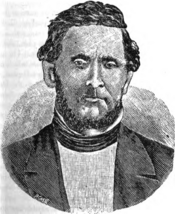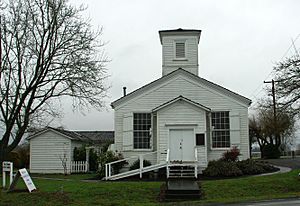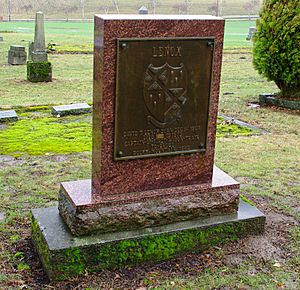David Thomas Lenox facts for kids
Quick facts for kids
David Thomas Lenox
|
|
|---|---|
 |
|
| Probate Judge of Washington County | |
| In office 1850–1852 |
|
| Personal details | |
| Born | December 8, 1802 Catskill, New York, U.S. |
| Died | October 18, 1874 (aged 71) Weston, Oregon, U.S. |
| Resting place | West Union Baptist Church Cemetery 45°34′25″N 122°54′26″W / 45.573737°N 122.90733°W |
| Spouse | Louisa Swan |
David Thomas Lenox (born December 8, 1802 – died October 18, 1874) was an important American pioneer. He moved to the Oregon Country and started the very first Baptist Church west of the Rocky Mountains. Born in New York, he lived in Illinois and Missouri before leading the first wagon train on the famous Oregon Trail all the way to what is now Oregon. He also helped create many schools and churches. He even worked as a judge and a justice of the peace. In Oregon, he first settled near Hillsboro on the Tualatin Plains. Later, he moved to Eastern Oregon.
Contents
David Lenox's Early Life
David Lenox was born in Catskill, New York, on December 8, 1802. His parents were English and followed the Scotch Methodist faith. Sadly, he became an orphan when he was very young. This meant he had limited schooling.
At age 18, he left New York and went to Lexington, Kentucky. There, he worked on a large farm called a plantation. In 1826, he married Louisa Swan, the daughter of the plantation owner. David and Louisa had ten children together.
In 1829, the Lenox family moved to a farm in Rushville, Illinois. David farmed and also worked as a school teacher there. In 1832, he became a Baptist in Rushville. By 1840, Lenox sold his farm. He then moved to Todds Creek in Platte County. He bought timberland there for $5 an acre. In Missouri, he served as the clerk for his local church. After a few years, they decided their land wasn't good enough for their family. So, they decided to move to the Oregon Country.
Journey on the Oregon Trail
Around 1843, David Lenox was working as a contractor in Missouri (which is now Kansas). He was near Fort Leavenworth when he heard a speech about Oregon. The speech was given by Peter Hardeman Burnett. Lenox was already planning to go to the Willamette Valley. After the speech, he decided to travel with Burnett to Oregon.
They formed a wagon train for the long journey. They hired a man named Mr. Gantt to guide them to Fort Hall. On April 9, the group left Platte City, Missouri. This was the very first wagon train to travel the entire Oregon Trail to Oregon. Burnett was first chosen as the captain. But after just one day, he quit. Lenox was then elected as the new captain.
Some people with livestock worried they would slow down the group. So, the wagon train split into two parts. Lenox led the "light column" without the cattle. Jesse Applegate was the captain of the "cow column."
Even though Mr. Gantt was hired as a guide, the Rev. Marcus Whitman arrived on May 15. He joined the group at Westport, Missouri after they had already started. Whitman had just returned from a winter trip to Washington, D.C., from his mission in Oregon. He was then hired to guide them all the way to the Columbia River. This was in addition to Gantt's services. Asa Lovejoy also joined the group. He had traveled back east from Oregon with Whitman.
During the trip, Lenox and Whitman believed the wagon train should not travel on Sundays. This was because of their religious beliefs. On August 29, Whitman left the group after Fort Hall. He returned to his mission because he heard about trouble with Native Americans. But he promised to send a Cayuse chief to guide them across the Blue Mountains to the Columbia River.
Whitman later waited for the wagon train at the Snake River. He thought the crossing would be harder than expected. After the river crossing, Whitman left again. A Native American guide sent by Whitman arrived when the wagon train was at the Grande Ronde Mountains. This guide led them to the Whitman Mission. After one day there, the group headed for the Columbia River without Whitman. At The Dalles, the wagon train used rafts to go down the Columbia River to Fort Vancouver. This fort was across from the mouth of the Willamette River. Lenox finally arrived in Oregon City on the Willamette on November 26.
Life in Oregon
In 1844, David Lenox first settled on a piece of land he bought. This land was near what is now Hillsboro, Oregon, in a community called West Union. It was on the east Tualatin Plains. This farm later became known as the Joe Mecke farm. After living there briefly, he claimed a nearby 320-acre (130 ha) donation land claim and farmed the land. Lenox was the first person to bring corn to the Willamette Valley.
On May 25, 1844, he started the West Union Baptist Church in his own home. This was the very first Baptist church west of the Rocky Mountains. Lenox gave the land for both the church and the cemetery next to it. The church is built where his first cabin once stood. Lenox was chosen as a deacon for the church. In 1845, two of his daughters were the first Baptists to be baptized in Oregon.
In 1845, the Rev. Ezra Fisher and his family arrived at the Lenox home. They spent the winter living with the Lenox family. That winter, the cabin housed thirteen members of the Lenox family, six members of the Fisher family, and a widow with her three children. The cabin was 18 feet by 22 feet. In the spring, Lenox moved to a new cabin, and the Fisher family stayed in the old one.
In 1847, Lenox helped to create the Baptist Church in Oregon City. He also helped form the first Baptist Association on the West Coast in 1848. He served as the clerk for this group. After farming, Lenox later ran a store. On November 12, 1851, he helped start the West Union School District. This was the first school district in the county. He served on its first board of directors with Caleb Wilkins and James W. Chambers. In 1852, he was one of the first people to buy land in what became the city of Hillsboro, along with George W. Ebbert and Ralph Wilcox. In 1857, he and others formed the West Union Institute. This was meant to be a Baptist school. However, the school never held classes. Instead, it was transferred to a school in McMinnville run by Sebastian C. Adams. This school later became Linfield College.
Political Work
In the June 3, 1845, elections for the provisional government, Lenox ran to represent Tuality District in the legislature. He came in sixth place. David Hill, Morton M. McCarver, and J. W. Smith were elected to the House of Representatives instead. From 1847 to 1848, he worked as a justice of the peace in that district. In 1850, he ran to be a probate judge there. He was a Democrat and served in that role. He was the only judge in what had become Washington County.
Later Years
In 1870, Lenox moved to Weston, a city in Eastern Oregon. There, he bought a farm. David Thomas Lenox passed away on October 18, 1874, near Weston. He was 71 years old. After his death, he was buried on the farm. The exact spot of his grave at the Kees (or Blue Mountain) Cemetery was lost for a time. But it was found again in 1924. In 1924, the Baptists of Oregon placed a monument at his gravesite to honor him. In 1960, this group moved his remains and the plaque to the West Union Baptist Church Cemetery. This is where his wife was buried.



